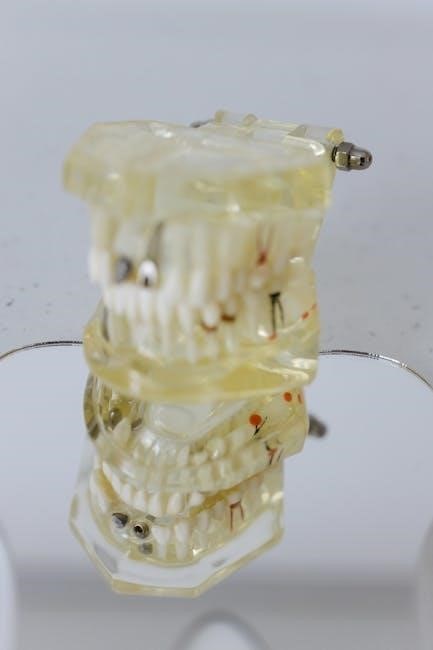
Dental assisting is a vital healthcare profession supporting dentists with patient care, procedures, and administrative tasks. It requires precision, attention to detail, and strong communication skills. Aspiring dental assistants benefit from comprehensive study guides and resources to master clinical techniques, terminology, and infection control protocols. Certification enhances career opportunities and ensures adherence to industry standards, making it a cornerstone of professional growth in this dynamic field.
What is a Dental Assistant?
A dental assistant is a trained healthcare professional who supports dentists and hygienists during patient care, procedures, and administrative tasks. Their role involves preparing treatment rooms, sterilizing instruments, and assisting with exams or surgeries. Dental assistants also handle patient records, schedule appointments, and educate patients on oral hygiene. They must possess strong communication skills, attention to detail, and the ability to follow infection control protocols. While responsibilities vary by practice, certified dental assistants often perform advanced tasks like taking X-rays or applying sealants. To become a dental assistant, one typically completes a training program and obtains certification through organizations like the Dental Assisting National Board (DANB). This role is essential for ensuring efficient dental office operations and providing quality patient care.
Importance of Certification
Certification is crucial for dental assistants as it validates their expertise, enhances credibility, and opens doors to advanced career opportunities. Certified dental assistants demonstrate a higher level of competence, which is often required by employers. The Dental Assisting National Board (DANB) offers certifications like the Certified Dental Assistant (CDA) credential, which is recognized nationwide. Certification also ensures adherence to industry standards and patient safety protocols. Additionally, it provides access to specialized resources, such as free PDF study guides and online courses, which aid in exam preparation. Many states require certification for performing specific tasks, such as taking X-rays or applying dental sealants. By obtaining certification, dental assistants not only advance their skills but also contribute to delivering high-quality patient care and maintaining a professional reputation in the field.

Overview of Dental Assistant Certifications
Dental assistant certifications validate skills and knowledge, ensuring professionals meet industry standards. The DANB offers credentials like the Certified Dental Assistant (CDA), recognized nationwide, enhancing career opportunities.

Types of Certifications
Several certifications are available for dental assistants, each with specific focuses. The Certified Dental Assistant (CDA) is the most common, offered by the Dental Assisting National Board (DANB). Specialized certifications include the Certified Orthodontic Assistant (COA) for orthodontics and the Certified Preventive Functions Dental Assistant (CPFDA) for preventive procedures. Additionally, some states offer state-specific certifications, reflecting local regulations. These certifications demonstrate expertise in areas like radiology, sedation, or dental materials. Each certification has unique requirements, such as passing exams or completing coursework. Having multiple certifications can broaden career opportunities and enhance professional credibility. Certifications also signal a commitment to staying updated with industry advancements, making certified assistants more competitive in the job market.
Benefits of Getting Certified
Obtaining certification as a dental assistant offers numerous benefits. It enhances your skills and knowledge, making you more competent in clinical and administrative tasks. Certification also boosts job prospects, as many employers prefer or require certified dental assistants. Additionally, certified assistants often earn higher salaries and gain greater credibility in the workplace. Certification demonstrates a commitment to professionalism and patient care, which can increase patient trust. It also provides opportunities to specialize in areas like orthodontics or radiology, further advancing your career. Moreover, certification ensures you stay updated with industry standards and advancements, making you a valuable asset to any dental team. Overall, certification is a key step in achieving long-term success and growth in this rewarding field.
Certification Requirements
To become a certified dental assistant, specific requirements must be met. Most states require completion of a dental assisting program accredited by the Commission on Dental Accreditation (CODA). Typically, these programs include both classroom and clinical training. Many certifications, such as the Certified Dental Assistant (CDA) credential, require passing a national exam administered by the Dental Assisting National Board (DANB). Some states also mandate additional certifications in radiology or infection control. Requirements may vary by state, so checking local regulations is essential. Applicants must also meet age and educational prerequisites, often including a high school diploma or equivalent. Additionally, some certifications may require background checks or current CPR certification. Meeting these requirements ensures compliance with industry standards and prepares assistants for successful careers in dentistry.

Key Topics Covered in the Study Guide
The study guide covers essential topics such as dental anatomy, terminology, clinical procedures, radiology basics, infection control, patient assessment, and dental materials. These subjects are comprehensively covered.
- Anatomy and Physiology
- Dental Terminology
- Clinical Procedures
- Radiology Basics
- Infection Control
- Patient Assessment
- Dental Materials
Anatomy and Physiology
The dental assistant study guide emphasizes the importance of understanding human anatomy and physiology, particularly focusing on the head, neck, and oral cavity. This section covers the structure and function of teeth, gums, jawbones, and related tissues. Students learn about the classification of teeth, their development, and the surrounding supporting structures. The guide also delves into the temporomandibular joint (TMJ) and its role in jaw movement. Understanding these concepts is crucial for assisting in procedures like fillings, extractions, and implants. The study material also includes detailed diagrams and illustrations to help visualize the anatomical relationships. This foundational knowledge enables dental assistants to communicate effectively with patients and perform their duties confidently. Mastery of anatomy and physiology is essential for both clinical and radiological aspects of dental assisting.
Dental Terminology
Dental terminology is a foundational component of the dental assistant study guide, focusing on the specialized vocabulary used in dentistry. This section helps learners understand and accurately use terms related to teeth, oral structures, procedures, and instruments. Common terms include classifications of teeth, types of restorations, and names of dental tools. The guide also covers medical and anatomical terms relevant to patient care. Mastery of dental terminology is essential for clear communication among dental team members and accurate documentation. Interactive exercises and flashcards are often included to reinforce learning. Understanding these terms enhances professionalism and ensures precise communication during patient interactions and procedural explanations. This knowledge is vital for both clinical efficiency and effective patient care in a dental setting.
Clinical Procedures
Clinical procedures are a core focus of the dental assistant study guide, detailing the practical tasks performed in a dental setting. This section covers preparation for patient care, instrument handling, and assisting during treatments. Key topics include infection control protocols, proper handwashing, and sterilization techniques. Students learn about dental impression procedures, fluoride treatments, and restorative processes. The guide also explains how to assist with extractions, crown placements, and other surgical procedures. Emphasis is placed on maintaining asepsis and ensuring patient safety. By mastering these clinical skills, dental assistants can efficiently support dentists and hygienists, enhancing overall patient care. Practical step-by-step guides and visual aids are often included to simplify learning. Understanding these procedures is essential for effective teamwork and delivering high-quality dental services.
Radiology Basics
Radiology basics are essential for dental assistants, focusing on understanding dental imaging techniques. This section covers types of X-rays, including intraoral (e.g., bitewing, periapical) and extraoral (e.g;, panoramic, cephalometric) radiographs. Students learn about the equipment used, patient positioning, and exposure techniques. The guide emphasizes radiation safety, adhering to the ALARA principle (As Low As Reasonably Achievable) to minimize exposure. Dental assistants are taught how to prepare patients, positioning them correctly and using protective gear like lead aprons. The section also explains how to process and digitalize images, ensuring clarity for accurate diagnoses. Understanding radiology basics enables dental assistants to assist effectively in diagnostic procedures, enhancing patient care and streamlining dental workflows. Practical tips and diagrams are often included to aid comprehension and application.
Infection Control
Infection control is a critical component of dental assisting, ensuring patient and provider safety. The section covers standard precautions, including hand hygiene, use of personal protective equipment (PPE) like gloves and masks, and proper surface disinfection. Dental assistants learn how to prepare treatment areas, sterilize instruments, and manage biohazardous waste. The guide emphasizes the importance of following CDC and OSHA guidelines to prevent cross-contamination. Proper techniques for disinfecting surfaces, such as using EPA-approved disinfectants, are detailed. Sterilization methods, including autoclaving and dry heat sterilization, are explained to ensure instrument safety. Sharps safety, including proper handling and disposal of needles, is also addressed. Effective infection control protocols help maintain a safe dental environment and prevent disease transmission.
Patient Assessment
Patient assessment is a fundamental skill for dental assistants, ensuring comprehensive care. It involves gathering vital information about the patient’s health history and current condition. The section covers reviewing medical history, including allergies, medications, and systemic diseases, which may impact dental treatment. Dental assistants learn to assess vital signs such as blood pressure, pulse, and oxygen saturation to ensure patient safety. Visual examination of the oral cavity, including soft tissues, gums, and teeth, is also emphasized. This process helps identify potential issues and guides personalized treatment plans. Effective communication techniques are highlighted to build trust and ensure accurate patient information. Proper documentation of findings is stressed to maintain clear records and support effective care delivery. Accurate patient assessment is crucial for safe and effective dental care.
Dental Materials
Dental materials are essential tools in dental care, and understanding their properties and uses is vital for dental assistants. This section covers common materials like amalgam, composite resins, and impression materials, detailing their applications in restorations and diagnostics. Dental cements, such as zinc phosphate and glass ionomer, are discussed for their role in bonding restorations. Gypsum products, like plaster and stone, are explained for creating dental casts. The guide also addresses instruments used for handling materials, such as mixing paddles and curing lights. Proper handling, storage, and safety precautions are emphasized to ensure material longevity and patient safety. Understanding dental materials enhances efficiency and precision in clinical procedures, making this knowledge crucial for effective dental assisting. This section provides a clear overview of the materials encountered in daily practice.

Dental Assistant Exam Details
The exam evaluates knowledge and skills in dental assisting, covering clinical procedures, patient care, and infection control. It typically includes multiple-choice questions and practical demonstrations. Preparation is key for success.
Types of Exams
There are several types of exams for dental assistants, including the Certified Dental Assistant (CDA) exam and the Certified Orthodontic Assistant (COA) exam. The CDA exam, offered by the Dental Assisting National Board (DANB), is the most common and highly recognized. It assesses knowledge in three key areas: General Chairside Assisting, Radiation Health and Safety, and Infection Control. The COA exam focuses specifically on orthodontic assisting skills. Some states also require additional certification exams for specialized procedures, such as dental sedation or impressions. These exams typically consist of multiple-choice questions and may include clinical demonstrations, depending on the certification. Passing these exams demonstrates competence and commitment to the profession, enhancing career opportunities. Proper preparation using study guides and resources is essential for success.
Exam Format and Structure
The Certified Dental Assistant (CDA) exam, administered by the Dental Assisting National Board (DANB), typically consists of three main sections: General Chairside Assisting, Radiation Health and Safety, and Infection Control. The exam format includes multiple-choice questions designed to test knowledge and application of key concepts. Candidates are usually allotted a specific time frame, such as 90 minutes, to complete the exam. Some certifications may also include clinical components, depending on the state or specialized area, such as orthodontics or sedation. The exam structure ensures candidates demonstrate both theoretical understanding and practical skills. Familiarizing oneself with the format is crucial for effective preparation, as it helps allocate study time efficiently and reduces test-day anxiety.
Content Outline
The content outline for the dental assistant exam is designed to cover essential topics that ensure comprehensive knowledge and skills. It typically includes sections like patient assessment, infection control, radiology basics, and clinical procedures. Each section is broken down into subtopics, such as anatomy, dental terminology, and materials. The outline emphasizes foundational concepts, like understanding tooth structure and periodontal charting, as well as practical skills, such as instrument identification and impression techniques. Additionally, it addresses patient safety, including emergency procedures and medical legal issues. The content outline serves as a roadmap for candidates, helping them identify key areas to focus on during their preparation. By mastering the outlined topics, dental assistants can confidently apply their knowledge in real-world clinical settings. This structured approach ensures the exam accurately reflects the skills needed for success in the field. Proper preparation aligns closely with the outlined content to guarantee readiness.
Sample Questions and Answers
Sample questions and answers provide valuable insights into the format and content of the dental assistant exam. These resources help candidates familiarize themselves with the types of questions they may encounter, such as multiple-choice, true/false, and scenario-based queries. Topics often include clinical procedures, radiology basics, and infection control. For example, a question might ask, “What is the proper procedure for sterilizing dental instruments?” with answers ranging from correct methods to common mistakes. Additionally, scenario-based questions test practical knowledge, such as handling patient emergencies or preparing materials for procedures. The answers are typically accompanied by explanations to clarify correct responses and common errors. Utilizing sample questions and answers enhances preparation by identifying knowledge gaps and improving test-taking strategies. They are an essential tool for building confidence and ensuring readiness for the exam. Regular practice with these samples is highly recommended.

Effective Study Resources
- Free PDF study guides provide comprehensive outlines and key concepts.
- Online courses offer interactive learning and flexible pacing.
- Flashcards and apps aid in memorizing terminology and procedures.
- Recommended textbooks cover in-depth topics like anatomy and radiology.
- Video tutorials and lectures visualize clinical techniques and patient care.
Free PDF Study Guides
Free PDF study guides are an excellent resource for dental assistant candidates, offering a cost-effective way to prepare for certification exams. These guides are often comprehensive, covering key topics such as dental terminology, anatomy, and clinical procedures. Many PDFs include practice questions, diagrams, and summaries of essential concepts, making them ideal for self-study. They are easily accessible online and can be downloaded for offline use, allowing flexibility in study schedules. Some guides are designed by professional organizations, ensuring credibility and relevance. While they may not replace formal textbooks, free PDFs provide a valuable starting point or supplement for exam preparation. Utilizing these resources alongside other study materials can enhance understanding and retention of critical dental assisting concepts.
Online Courses and Tutorials
Online courses and tutorials are a valuable resource for dental assistant exam preparation, offering structured learning opportunities. These programs often include video lessons, interactive quizzes, and downloadable materials, making them engaging and effective. Many courses are designed by experienced instructors and cover topics like clinical procedures, radiology, and infection control. They provide flexibility, allowing students to study at their own pace and revisit challenging concepts. Some platforms offer certification upon completion, enhancing credibility. Additionally, online forums and discussion groups connect learners, fostering collaboration and problem-solving. These courses complement study guides and practice tests, ensuring a well-rounded preparation strategy. They are particularly beneficial for those balancing work or other responsibilities, offering convenience and accessibility.
Flashcards and Mobile Apps
Flashcards and mobile apps are excellent tools for active learning and on-the-go preparation for the dental assistant exam. Flashcards help reinforce memorization of key terms, procedures, and concepts, such as dental terminology and anatomy. Mobile apps often include interactive features like quizzes, progress tracking, and spaced repetition systems to optimize retention. Popular apps for dental assisting studies offer access to digital flashcards, practice questions, and study guides. They are particularly useful for visual and auditory learners, as they provide engaging and accessible ways to review material. Many apps are free or low-cost, making them an affordable supplement to traditional study methods. Using flashcards and apps regularly can significantly enhance preparation and confidence for the certification exam.
Recommended Textbooks
Several textbooks are highly recommended for dental assistant students to complement their study guide. Titles like “Dental Assisting: A Comprehensive Approach” by Doni L. Bird and “Modern Dental Assisting” by Debra S. Robinson are widely acclaimed for their detailed coverage of clinical procedures, anatomy, and terminology. These books provide in-depth explanations of dental materials, radiology, and infection control, aligning with the topics covered in the study guide. Additionally, “Dental Assisting Review: Prepare for the CDA Exam” by Joen Iannucci is an excellent resource for exam preparation. These textbooks are available in paperback and digital formats, offering flexibility for different learning preferences. They serve as valuable references for both classroom learning and self-study, ensuring a comprehensive understanding of dental assisting principles and practices.
Video Tutorials and Lectures
Video tutorials and lectures are excellent resources for visual learners preparing for dental assistant certification. Platforms like YouTube offer numerous free channels, such as “Dental Assistant Training” and “DAHelpers”, providing step-by-step demonstrations of clinical procedures, radiology techniques, and infection control protocols. Paid platforms like Coursera and Udemy feature comprehensive video courses covering dental terminology, anatomy, and patient assessment. These lectures often include interactive elements, quizzes, and downloadable materials. Additionally, video tutorials allow learners to pause, rewind, and rewatch complex procedures, enhancing understanding and retention. Many videos also include real-life patient scenarios, helping students apply theoretical knowledge to practical situations. Incorporating video resources into your study routine can significantly enhance your preparation for the certification exam and improve your clinical skills.

Study Tips and Techniques

Effective studying involves active learning, time management, and test-taking strategies. Use flashcards to memorize dental terminology and procedures. Practice regularly with sample questions to build confidence and retention.
Time Management
Effective time management is essential for success in studying for the dental assistant certification; Create a structured study schedule, allocating specific time slots for each topic. Set realistic daily goals to avoid burnout and ensure steady progress. Prioritize challenging subjects and review them during your most productive hours. Break study material into manageable chunks, focusing on one topic at a time. Use digital calendars or planners to organize study sessions and deadlines. Avoid procrastination by dedicating short, focused intervals to complex tasks. Balance study time with breaks to maintain concentration and prevent mental fatigue. Regularly review and adjust your schedule to stay on track and ensure all topics are covered thoroughly.

Active Learning Strategies
Active learning strategies are crucial for effectively studying dental assisting material. Engage with the content by summarizing key points in your own words, which reinforces understanding. Use self-quizzing techniques to test your knowledge regularly, helping to identify areas needing improvement. Teach the material to others, as explaining concepts enhances retention. Apply knowledge through hands-on practice or simulations, making abstract ideas more tangible. Participate in study groups to discuss challenging topics and gain diverse perspectives. Actively take notes while reviewing study guides, focusing on critical details. Incorporate real-world examples to relate theory to practical scenarios. By actively engaging with the material, you deepen comprehension and improve long-term retention, ensuring better preparation for the certification exam and future clinical practice.
Test-Taking Strategies
Effective test-taking strategies are essential for success in the dental assistant certification exam. Start by carefully reading each question to understand what is being asked. Manage your time wisely, allocating a set amount to each question to avoid running out of time. Eliminate obviously incorrect answers first to increase the chances of selecting the right one. If unsure, make an educated guess rather than leaving the question blank. Stay calm and focused to maintain clarity of thought. Review your answers if time permits, but avoid second-guessing yourself unless certain of an error. Employing these strategies can help you approach the exam with confidence and maximize your score, ensuring you are well-prepared to excel in your dental assisting career.
Importance of Practice Tests
Practice tests are a vital component of preparing for the dental assistant certification exam; They provide students with a realistic simulation of the actual test environment, helping to build confidence and reduce exam-day anxiety. By taking practice tests, individuals can identify areas where they need additional review and focus their study efforts more effectively. Regular practice also improves time management skills, as students learn to allocate their time wisely for each question. Additionally, practice tests expose learners to various question formats and content, ensuring they are well-prepared for the types of questions they will encounter. Consistently taking practice tests can significantly enhance overall performance and readiness for the certification exam, making them an indispensable study tool for aspiring dental assistants.
Staying Motivated

Staying motivated is crucial when preparing for the dental assistant certification exam. Setting clear, achievable goals helps maintain focus and direction. Celebrate small victories, like mastering a challenging topic, to keep morale high. Creating a positive study environment, free from distractions, can enhance concentration and productivity. Surrounding yourself with supportive peers or mentors who encourage your progress can also boost motivation. Reminding yourself of the long-term benefits of becoming a certified dental assistant, such as career advancement and increased earning potential, can help maintain determination. Lastly, incorporating regular breaks and self-care practices ensures you stay energized and motivated throughout your study journey.
Congratulations! You’ve successfully navigated the Dental Assistant Study Guide. Mastering the material ensures confidence and competence, leading to a rewarding career. Stay dedicated, and embrace the opportunities ahead!
Final Tips for Success
To excel as a dental assistant, stay organized and dedicated to your studies. Set realistic goals, prioritize challenging topics, and review regularly. Engage in active learning by summarizing key concepts and discussing them with peers. Utilize practice tests to identify weak areas and refine your test-taking strategies. Seek guidance from instructors or experienced professionals when needed. Maintain a healthy work-life balance to avoid burnout. Lastly, stay motivated by reminding yourself of your career goals. With persistence and the right resources, such as a dental assistant study guide PDF free, you’ll achieve success and excel in your certification exam and future career.
Continuous Learning
Continuous learning is crucial for dental assistants to stay updated on advancements in dental care and technologies. The field evolves rapidly, requiring professionals to adapt and expand their skills. Engage in ongoing education through workshops, webinars, and professional organizations. Subscribe to dental journals and online forums to stay informed about new techniques and best practices. Utilize resources like a dental assistant study guide PDF free to reinforce knowledge and explore emerging trends. Regularly review and update your skills in areas such as patient communication, infection control, and clinical procedures. By committing to lifelong learning, you enhance your expertise, ensuring quality patient care and long-term career success.
